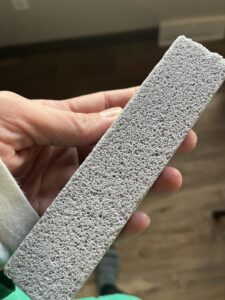If you have glass shower doors, you know the battle that it comes with. Soap scum is a formidable opponent and can be overwhelming to tackle – especially without chemicals. What’s the best way to clean a glass shower door? This old fashioned cleaning aid is a surprising superhero.
We installed glass shower doors several years ago. We have a small bathroom that was made seemingly smaller with a shower curtain, so they felt like the best option. Not to mention that cleaning plastic shower curtains is gross, tedious, and incredibly wasteful.
Installing glass shower doors, of course, was not an easy task, nor an inexpensive upgrade, but it really did open up the space!
And wow, those first few showers felt delightfully free.
And then the soap scum started to accumulate….

This post contains affiliate links.
Cleaning a glass shower door
The first few times I cleaned the shower door, it went pretty smoothly. I made a concoction of dish detergent, citric acid, and salt. It worked pretty well, but eventually, that wasn’t enough.
(We also have a painted tub, so this concoction wasn’t the most friendly option for our tub & tile paint.)
I tried to research some alternatives, but they were either heavy on the chemicals, or required steel wool. This didn’t sit right with me. Steel wool is going to leave scratches in your surface and you need to wear gloves while using it.
Pumice, however, won’t scratch if used correctly. It’s also easily kept in the shower, so I’m more likely to just do it when I have a few extra minutes.
What is pumice?
Pumice is a natural stone created in the volcanic process. It’s basically soft rock full of air. Pumice is mined, cut, packaged, and shipped for its many uses.

Is pumice environmentally friendly?
Pumice is a clean alternative to chemical cleaners in your home. However, like all other things, its manufacture (or in this case, mining) does have an environmental impact.
Mining disrupts habitats, causes air and water pollution, and is affects the surrounding soil and topographies.
However…
Using pumice to clean your home is one of the smaller uses for this product. Pumice is used in construction, landscaping, cosmetics, and clothing manufacture. (Who doesn’t love a pair of soft jeans?)
If you’re like me, you do a lot of weighing:
- Our family largely relies on secondhand items — this includes landscaping projects. (Check out our walkway made with antique bricks!)
- 90% of the items in our closets are secondhand and about half the furniture.
- We eat mostly vegetarian.
- We buy almost no commercial cosmetic or cleaning products (and try to minimize the impact when we do — like with our laundry detergent).
This said, it’s about progress, not perfection, and our purchase of a handful of pumice stones every few years is contributing very little to the industry. And it definitely has less of an environmental impact than several bottles of chemical cleaners.
What is the correct way to use a pumice stone?
Remove excess soap scum
When I use a pumice stone on my shower door, I always start by cleaning the surface with a quick scrub of dish detergent. This clears away any of the easily removable film which will clog the pores of the stone and make your job more difficult.
Keep the stone wet
The correct way to use a pumice stone is wet. By keeping the stone and the surface wet at all times, you’re reducing friction and shouldn’t develop any noticeable scratches.
I tend to soak your stone while I scrub the door with soap – or just leave it on a shower ledge. 🙂
Further reduce friction with soap
I’ll frequently add some dish detergent directly onto the stone, as well. It seems to make it less sticky in the tough-scrub zones and reduces friction, which, in turn, will reduce the chance of scratches.
Scrub!
Once I start scrubbing, I like to move in slow circles across the door’s surface, so I don’t lose track of where I am.
When you’re done, just rinse away! If it sits for a while, that’s fine, too!
Can I use pumice stones on other surfaces?
Yes! You can use a pumice stone on all kinds of grungy items. Pretty much anything that’s porcelain or tempered glass is a candidate. Some people worry about scratching the surface, but, like I said, if used wet, it shouldn’t create any noticeable scratches.
I also find that if I’m using a pumice stone to clean an item, I’ve probably already tried everything else.
Rust in your sinks and toilets, baking dishes (you know, that Pyrex one that you use for everything?), soap scum, and –get this – scratches! (Like the kind from metal on porcelain. Weird, right?)
Anyway, adding pumice stones to your cleaning arsenal is one of the easiest and least expensive things you can do. It also makes sure that your cleaning products stay – well – clean. 🙂
Where can I buy pumice stones?
Check your local hardware store! We live in a pretty small town and the local hardware store did not have pumice stones (However, they’re frequently out of anything we happen to be looking for anyway.) Even the local Wal-Mart doesn’t keep them in stock. (Not even the pedicure kind!) So we purchased a bag of them on Amazon.
As a pack of five, they should last a very long time. I can also give them away to others if I ever get in a conversation about a cleaning dilemma. I do enjoy sharing a good hack. Sharing is caring, afterall!
Speaking of, would you please share this post with a friend or family member? It would mean the world to us and our little business. 🙂

Thank you and take care!
Melissa, The Joneses Four




